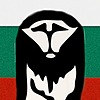HOME | DD
 mihailnikoloff — The Magic Square, Old Church Slavonic, Bulgaria
mihailnikoloff — The Magic Square, Old Church Slavonic, Bulgaria

#bulgaria #cyrillic #glagolitic #magic #magician #manuscript #slavonic #slavs #square
Published: 2024-04-05 08:37:56 +0000 UTC; Views: 748; Favourites: 5; Downloads: 0
Redirect to original
Description
The Tetraevangelia of Ivan Alexander (Bulgarian: Четвероевангелие на (цар) Иван Александър) is an illuminated manuscript Gospel Book, written and illustrated in 1355–1356 for Tsar Ivan Alexander of the Second Bulgarian Empire. It is regarded as one of the most important monuments of medieval Bulgarian culture. The manuscript contains the text of the Four Gospels illustrated with 366 water-colour miniatures and consists of 286 parchment sheets. Gold leaf is used in the embellishment of the illustrations and the enlarged initial letters.
After Bulgaria's capital Tarnovo fell to the Ottomans in the summer of 1393, the four gospels were exported to Moldova, where they were bought by the Moldavian ruler Alexander the Good. In the 17th century, it fell, probably as a gift of the Moldavian princes, to the "St. Paul" monastery in Mount Athos. In 1837, the Englishman Baron Robert Curzon visited the monastery and (according to his own words) received it as a gift from the abbot. The precious manuscript remained in the possession of the Englishman's family until 1917, when his daughter donated it along with his entire collection of books to the British Museum in London. It was later moved to the British Library when it was founded in 1973.
Ivan Alexander began his rule as a despot of Lovech city and its region. After the coup against Tsar Ivan Stephan, Alexander gradually won the trust of Tarnovo and was elected as the new tsar. In 1332 he won an important battle at Rusokastro, which returned to Bulgaria the lands of today’s southern Black Sea coast. He later won Plovdiv and a number of fortresses in the Rhodope Mountains, contributing to establishing the Bulgarian character of these lands.
Historians accuse Ivan Alexander that in 1351 he refused to form a coalition with the Byzantine Emperor John Cantacuzene against the Ottomans. This circumstance was considered decisive in the development of Balkan history. But the picture of the XIV century is not so simple. The invasion of the Ottomans was underestimated in Europe and the Byzantines themselves often used their mercenaries in dynastic wars and against the Bulgarians. In fact the Ottomans conquered a region torn by feudal struggles.
#bulgaria #middleages #manuscripts #evangelie #gospel #london #british #museum #balkans #byzantium #cyrillic #tsar #alexander
#slavonic #bulgarian #script #gospels #orthodoxy #pravoslavie

















